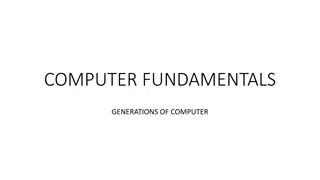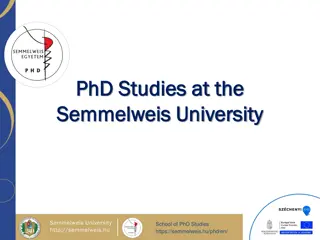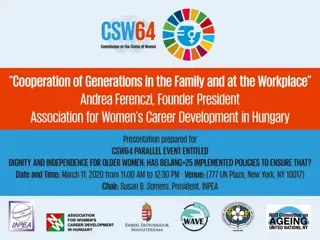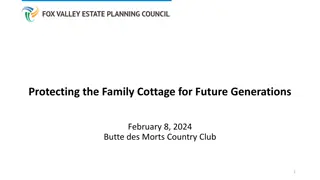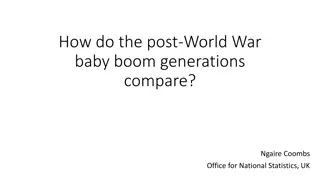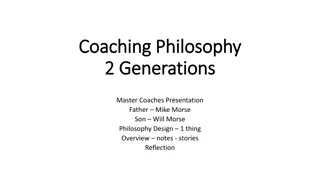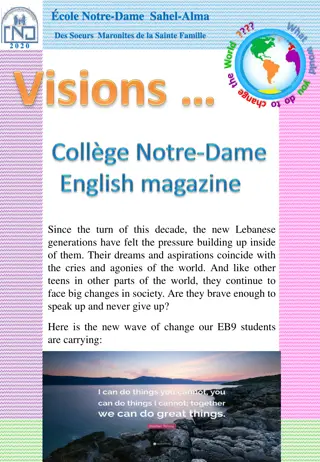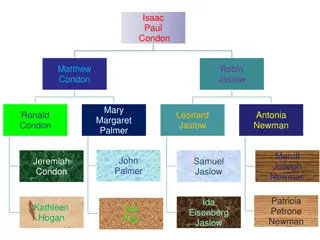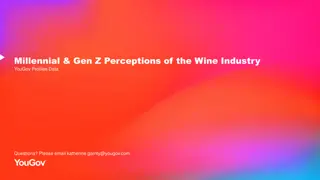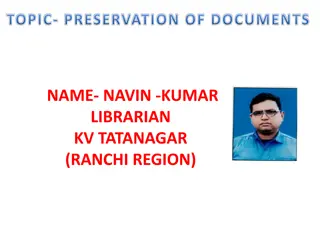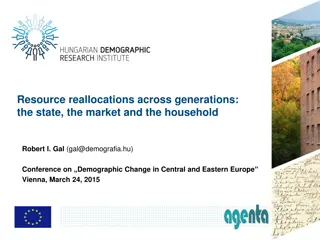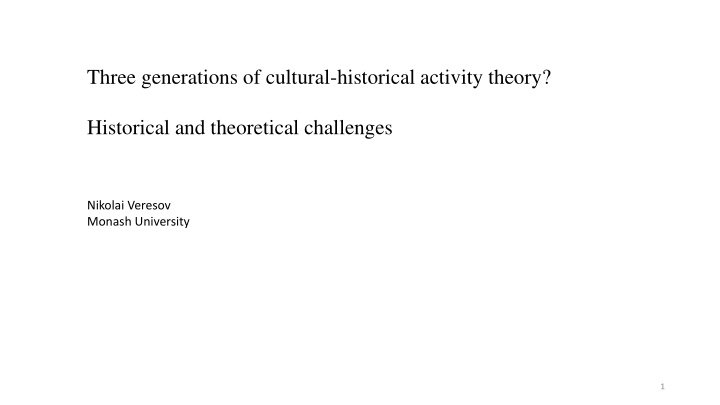
Cultural-Historical Activity Theory: Three Generations Explained
Explore the evolution of Cultural-Historical Activity Theory through three generations - from Vygotsky to Engestrom. Discover the unit of analysis, principles, and key theorists shaping this developmental concept.
Download Presentation

Please find below an Image/Link to download the presentation.
The content on the website is provided AS IS for your information and personal use only. It may not be sold, licensed, or shared on other websites without obtaining consent from the author. If you encounter any issues during the download, it is possible that the publisher has removed the file from their server.
You are allowed to download the files provided on this website for personal or commercial use, subject to the condition that they are used lawfully. All files are the property of their respective owners.
The content on the website is provided AS IS for your information and personal use only. It may not be sold, licensed, or shared on other websites without obtaining consent from the author.
E N D
Presentation Transcript
Three generations of cultural-historical activity theory? Historical and theoretical challenges Nikolai Veresov Monash University 1
What do we know about three generations of activity theory? 2
Engestrm, Y. (1987). Learning by expanding: An activity-theoretical approach to developmental research (Helsinki, Orienta-Konsultit). Engestrom, Y. (1990). Learning, working, imagining: Twelve studies in activity theory. Helsinki: Orienta- Konsultit. Cole, M. and Engestr m, Y. (1993) A cultural-historical approach to distributed cognition, in: G. Salomon (Ed.), Distributed cognitions: Psychological and educational considerations (New York, Cambridge University Press), 1-46. Engestr m, Y, Miettinen, R. & Punam ki, R. (Eds.). (1999). Perspectives on activity theory. New York: Cambridge University Press. Engestr m, Y. (1999) Innovative learning in work teams: analysing cycles of knowledge creation in practice, in: Y. Engestrom et al (Eds.) Perspectives on Activity Theory, (Cambridge, Cambridge University Press), 377-406. Cole, M., & Engestr m, Y. (2007). Cultural-historical approaches to designing for development. In Valsiner, J., & Rosa, A. (Eds.). The Cambridge handbook of sociocultural psychology (pp. 484-507). Cambridge: Cambridge University Press. 3
Generations Time Names Unit of analysis Principle 1st Generation 2nd Generation 3rd Generation 4
Generations Time Names Unit of analysis Principle 1st Generation 1920s-1930s Vygotsky mediated action mediation 2nd Generation 1930s-1970s Leontiev triangle of activity activity 3rd Generation 1970s - now Engestrom activity system transformation 5
First generation Unit of analysis: mediated action (Engestrom, 2008) Mediational Means (Tools) (machines, writing, speaking, gesture, architecture, music, etc) Subject(s) Object/Motive --> Outcome(s) (individual, dyad, group) 6
Generations: First generation Lev Vygotsky (1896-1934) Cultural-historical theory of development of higher mental functions 9
Vygotsky cultural-historical theory A. Leontiev = activity theory L. Bozhovich = theory of personality M. Lisina = theory of communication N. Morozova = development and special education 11
Generations: First generation Lev Vygotsky (1896-1934) 1930s-1970s First generation of activity theory Second generation of cultural- historical theory 12
1930s-1970s First generation of activity theory (Leontiev, Elkonin, Galperin, Zaportozhets, P. Zinchenko) Second generation of cultural- historical theory (Lisina, Bozhovich) 1970s 2000s Second generation of activity theory(V. Davydov, D. Elkonin, J. Lompsher, G. R ckriem) Third generation of cultural- historical theory (V. Zinchenko, E. Kravtsova, M. Fleer, N. Veresov, P. Hakkarainen Third generation of activity theory (Rubtsov, Zuckernan, B. Elkonin) CHAT (cultural-historical activity theory) M. Cole, J. Wertsch, Y. Engestrom 13
NOW Three co-existing theoretical approaches: Cultural-historical theory Activity theory Cultural-historical activity theory 14
First generation: cultural-historical theory (Vygotsky) Key ideas of cultural-historical theory? 15
Socio-cultural genesis of human consciousness (higher mental functions) Dialectical character of cultural development (contradictions, crises, drama, new quality=neoformations) Mediation Other? 16
First generation: Vygotsky Unit of analysis: mediated action (Engestrom, 2008) Mediating Means (Tools) (machines, writing, speaking, gesture, architecture, music, etc) Subject(s) Object/Motive --> Outcome(s) (individual, dyad, group) 17
Vygotsky: Mediated action IS NOT a unit of analysis: This form of analysis relies on the partitioning of the complex whole into units. In contrast to the term "element," the term "unit" designates a product of analysis that possesses all the basic characteristics of the whole. The unit is a vital and irreducible part of the whole... By unit we mean a product of analysis which, unlike elements, retains all the basic properties of the whole and which cannot be further divided without losing them (Vygotsky, 1987, p 46-47) Mediated action as a higher form of behaviour, can always be divided completely and without any remainder into the natural elementary processes that make it up, just as the work of any machine can, in the last analysis, be reduced to a definite system of physicochemical processes (Vygotsky, 1997, p.80). 18
Vygotsky: The concept "development of higher mental functions" and the subject of our research encompass two groups of phenomena that seem, at first glance, to be completely unrelated, but in fact represent two basic branches, two streams of the development of higher forms of behavior inseparably connected, but never merging into one. These are, first, the processes of mastering external materials of cultural development and thinking: language, writing, arithmetic, drawing; second, the processes of development of special higher mental functions not delimited and not determined with any degree of precision and in traditional psychology termed voluntary attention, logical memory, formation of concepts, etc. Both of these taken together also form that which we conditionally call the process of development of higher forms of the child's behaviour (Vygotsky, 1997, p. 14). 19
...every function in the cultural development of the child appears on the stage twice, in two planes, first, the social, then the psychological, first between people as an intermental category, then within the child as a intramental category...Genetically, social relations, real relations of people, stand behind all the higher mental functions and their relations every higher mental function was external because it was social before it became an internal strictly mental function; it was formerly a social relation between two people (Vygotsky 1997, p. 106) 20
CHAT is a movement for improvement and modification (or even modernisation) of some of the basic concepts and principles of Vygotsky s approach, according to today s requirements (Cole, 1996; 1996a), or recently, as a kind of conceptual reformulation and combination of Vygotsky (principle of mediation) and A. Leont ev (principle of activity) (Cole, 2007). activity and mediation as two aspects of a single whole in human life world (Cole & Engestr m, 2007, p. 485). 22
CHAT: tools and signs = mediating artefacts Vygotsky: mediating activity of human being use of tools use of signs Our diagram presents both types of devices as diverging lines of mediating activity These activities are so different that even the nature of the devices used cannot be one and the same in both cases (Vygotsky, 1997, p.62). Even more vague is the idea of those who understand such expressions in a literal sense. Phenomena that have their own psychological aspect, but in essence do not belong wholly to psychology, such as technology, are completely illegitimately psychologized. The basis for this identification is ignoring the essence of both forms of activity and the differences in their historical role and nature. Tools as devices of work, devices for mastering the processes of nature, and language as a device for social contact and communication, dissolve in the general concept of artifacts or artificial devices (p.61). 23
The basic principle of the functioning of higher functions (personality) is social, entailing interaction of functions, in place of interaction between people. They can be most fully developed in the form of drama (Vygotsky 1929/1989, p.59; Original emphasis). 24
Leontiev principle of activity? No, the principle of the unity of conscious and activity: The activity of man makes up the substance of his consciousness (Leont ev, 1978, p.95). Psychological structure of consciousness corresponds to the structure of activity but is not identical to it the human activity and individual consciousness have common structure (Leont ev, 1978, p. 62). the process of internalization is not external action transferred into a pre-existing internal plan of consciousness ; it is the process in which this internal plan is formed (Leont ev, 1978, p.60). 25
Engestrm (1999) suggests that activity theory may be summarized with the help of five principles. They stand as a manifesto of the current state of activity theory: The first principle is that a collective, artifact-mediated and object-oriented activity system, seen in its network relations to other activity systems, is taken as the prime unit of analysis. Contradicts Vygotsky s concepts of tool/sign and their psychological nature mediating activity of a human being Contradicts Vygotsky s concept of unit of analysis Contradicts Leontiev s principle of the unity of consciousness and activity 27
Key ideas and challenges: Re-thinking Vygotsky s legacy: theory and research methodology What is development (dialectics of transformations and reorganisation) Mediated activity OR mediating activity? Subject of activity OR an individual in a process of becoming? Activity: Concept? Principle? Unit of analysis? Social formation of mind: what is social ? Social practices: how to approach? Social practices, activity, social situation of development, subjectivity. Perezhivanie as a theoretical concept. 28


